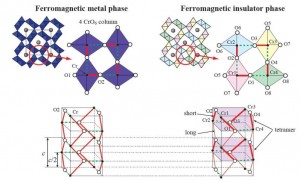The first ferromagnetic metal-to-ferromagnetic insulator transition

In 2009, Professor Yutaka Ueda and his team at the Institute for Solid State Physics at the University of Tokyo found that the hollandite-type oxide K2Cr8O16 remains ferromagnetic despite undergoing a phase transition from metal to insulator. The mechanism behind this ferromagnetic metal-to-ferromagnetic insulator transition, the first to be recorded, remained unknown.

It is well known that ferromagnetism emerges in a material when electron spin is aligned, and that ferromagnetism is closely related to the free movement of electrons in the metallic state. As a result, it was not known why this material retained its ferromagnetic properties despite undergoing a phase transition to an insulating state in which electrons cannot move about freely between its atoms.
In this research, Professor Ueda and research groups at the High Energy Accelerator Research Organization (KEK), using the KEK Photon Factory, found that the crystal structure of K2Cr8O16 distorts at low temperatures, undergoing a phase transition to become an insulator in which the movement of electrons is constrained. In addition, they discovered the mechanism of the metal-to-insulator transition by which the spin orientation of the electrons is preserved, in collaboration with a theoretical group at Chiba University.
This metal-to-insulator transition is accompanied by a structural change known as a Peierls transition; namely, Cr-O bond alternations are observed in a one-dimensional column formed by four CrO6 chains, which indicates the dimerization of the lattice with the formation of a Cr tetramer. In general, in a Peierls transition, lattice distortion results in atoms forming pairs and a newly formed orbital in the paired atoms is occupied by two electrons with opposite spins, leading to the nonmagnetic property of the material. However, in the case of K2Cr8O16, because each electron is weakly trapped between four chromium atoms (a Cr tetramer), spin orientation is preserved, and the material retains its ferromagnetic properties.
Elucidating the mechanism of this world-first Peierls transition, where the spin freedom of electrons plays no role, was achieved through the successful combination of theoretical calculation based on precise experimental observation.
(Public Relations Division: Euan McKay, Azusa Minamizaki)
Paper
T. Toriyama, A. Nakao, Y. Yamaki, H. Nakao, Y. Murakami, K. Hasegawa, M. Isobe, Y. Ueda, A. V. Ushakov, D. I. Khomskii, S. V. Streltsov, T. Konishi, Y. Ohta
“Peierls Mechanism of the Metal-Insulator Transition in Ferromagnetic Hollandite”
Phys. Rev. Lett. 107(26) (2011) [5 pages], doi:10.1103/PhysRevLett.107.266402
Article link
Links
Institute for Solid State Physics






